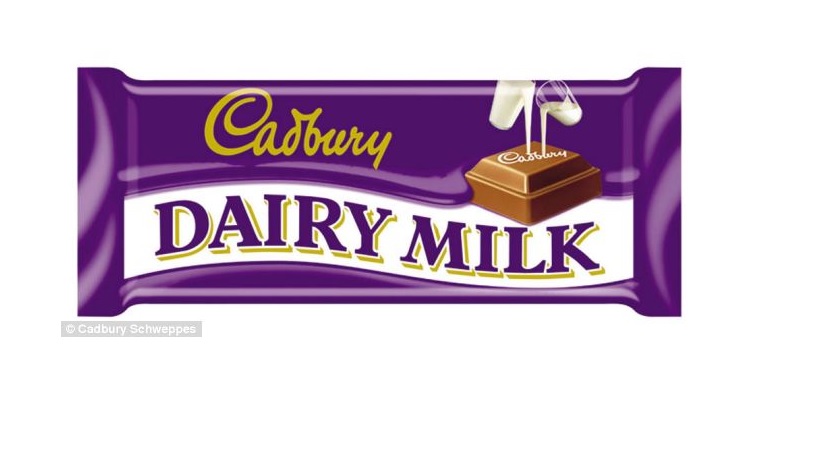“….unconventional or “exotic” marks, such as colours, sounds and smells, give rise to conceptual problems, which are not encountered with more conventional trade names and logos. As the registration of a trade mark creates a form of intellectual property conferring a potentially perpetual monopoly in the mark and excluding everybody else from use in various ways, the point of principle has some public importance.”
Recently, the England and Wales Court of Appeal in the case of Société Des Produits Nestlé S.A. v Cadbury UK Ltd. [2013] overturned a decision of the High Court to proceed with an application to register a trade mark for Cadbury’s chocolate, which featured a specified shade of the colour purple. In particular, the trade mark applied for by Cadbury was shown as a rectangle, which is a purple block when reproduced in colour, and described as:-
“The colour purple (Pantone 2685C), as shown on the form of application, applied to the whole visible surface, or being the predominant colour applied to the whole visible surface, of the packaging of the goods.” [Emphasis Mine]
According to Article 2 of the Trade Marks Directive 2008/95/EC, an application to register a trade mark must satisfy three conditions:-
(i) there must be a sign;
(ii) it must be capable of graphical representation;
(iii) it must be capable of distinguishing the goods or services of one undertaking from those of other undertakings.
Therefore Nestlé’s objection to registration was based on initial principles: that the colour mark described in the application was not registrable because it was not “a sign” and was not capable of being represented graphically.
In allowing Nestlé’s appeal, the court narrowed in on the above quoted description of the graphic representation of the mark applied for by Cadbury. In particular, the court held that the High Court erred in its interpretation of the phrase “or being the predominant colour applied to the whole visible surface” as contained in the description. It was held that this phrase and the use of the word “predominant”, in particular, opens the door to a multitude of different visual forms as a result of its implied reference to other colours and other visual material not displayed or described in the application and over which the colour purple may predominate. Therefore, if the colour purple is less than total, as would be the case if the colour is only “predominant”, the application would cover other matter in combination with the colour, but not graphically represented or verbally described in the specific, certain, self-contained and precise manner required.
Therefore, according to the court:
“To allow a registration so lacking in specificity, clarity and precision of visual appearance would offend against the principle of certainty. It would also offend against the principle of fairness by giving a competitive advantage to Cadbury and by putting Nestlé and its other competitors at a disadvantage.”
Comment:
This blogger has previously discussed the question of registration of colour trade marks in Kenya within the context of the Christian Louboutin “red sole” case. (see discussion here)
Indeed, colours have become an important mode of identifying an enterprise and its products. This has resulted in applications to trade mark colours themselves, rather than in the traditional manner in which enterprises only sought to register their trade/product name in a particular colour. Features like colours are very important in the ultra-competitive confectionery market, where issues like impulse-buying, supermarket till placement, and child pressure come into play.
From the cases, there are two problems in the application for registration of colour marks, namely: the graphical representation of the colour; and the manner in which the colour is described as being applied.
As for the graphical representation of the colour, the European Court of Justice (ECJ) in the Libertel Groep v. Benelux-Markenbureau case recommended that graphical representation take the form of reference to an internationally administered colour identification code, such as PANTONE, RAL or Focoltone, as those are always precise and stable. This approach seems to be internationally accepted, as trade mark offices recommend reference to an international colour identification code as well as a description of how the colour is to be applied. Therefore according to the Cadbury v Nestle case, registration of a colour mark is not possible unless the tests of being “clear, precise, self-contained, easily accessible, intelligible, durable and objective” are satisfied, even if the colour mark has become distinctive.
But even if one takes heed of the European authorities such as Libertel and other guidelines, the road to registration of a colour mark remains bumpy indeed. Cadbury has discovered this in the present case where despite its attempt to be very specific by describing the colour purple as Panton 2685C, its application was nevertheless opposed because the use of “predominant colour” in its description was unclear, subjective, indeterminate and allowed for alternatives.
Closer to home, South Africa’s 1993 Trade Marks Act allows applications for colours on their own, without reference to a device or logo of some kind. However, this practice changed since the decision in the case of Cadbury Ltd v Beacon Sweets & Chocolates (Pty) Ltd in 2004. This case involved an application by Cadbury to register ‘the colour purple’ as a mark in respect of chocolate confectionery in moulded slab form. It was held that although South African Trade Mark law allows colour marks, Cadbury had failed to prove the required distinctiveness by allowing the colour purple to be used by other parties in the confectionery field for too long.
All in all, it seems that although most jurisdictions agree that a colour should be registrable as a trade mark where it serves no functional or competitive purpose and where it has acquired a secondary meaning through use, there is still some inconsistency in the way these principles are applied.
